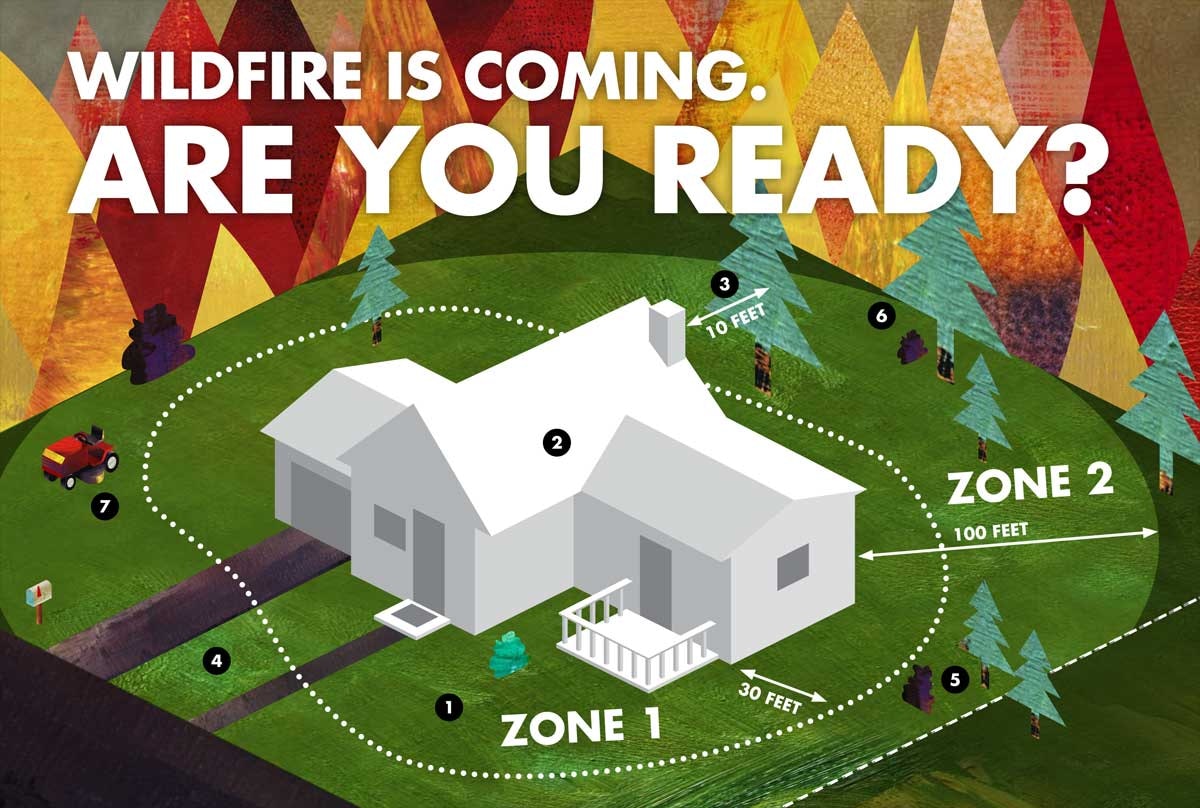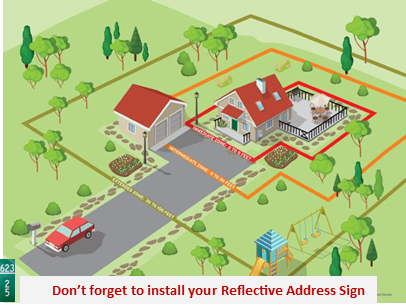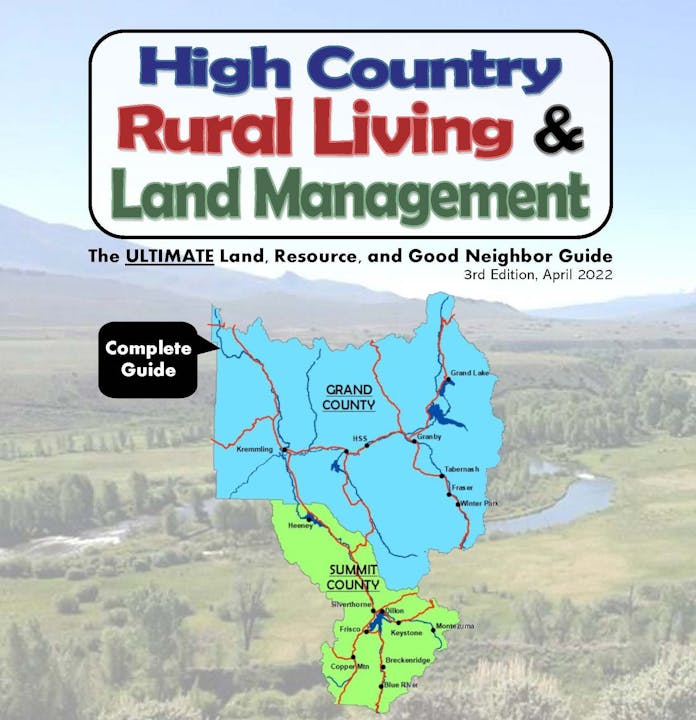Mitigating for Wildfire 2

ON THIS PAGE
- Zones of Defensible Space
- Home Ignition Zone
- For more topics on wildfires, visit Mitigating for Wildfire 1 & Mitigating for Wildfire 3
Intro
Each year, wildfires consume hundreds of homes in the Wildland-Urban Interface (WUI) despite firefighters’ best efforts. Studies show that as many as 80 percent of homes lost to wildland fires could have been saved if their owners had followed simple fire-safe practices. In addition, wildfire-related deaths often occur because people wait too long to leave their homes.
The Wildland-Urban Interface (WUI) is the area where human-made structures and developments meet and intermingle with undeveloped lands and vegetative fuels. The exact boundaries of the WUI depend on the topography, vegetative fuel types, local weather conditions, and prevailing winds. Nevertheless, if your home is within one mile of a natural area, it is likely within the Ember Zone (the zone where wind-driven embers, or firebrands, can threaten your home). You must prepare your home well before a wildland fire occurs. Ember fires can destroy homes and neighborhoods far from the actual flame front. Firebrands can also cause ignitions well after the fire has passed through a community.
It is not a question of if, but when, the next major wildland fire will occur. The tips below are designed to increase awareness and create a safer environment for you, your family, and the responding firefighters.
Grand and Summit County Wildfire Councils are here to help landowners mitigate for wildfire.
Grand County Wildfire Council | www.bewildfireready.org
Summit County Wildfire Council | www.co.summit.co.us/907/Wildfire-Council
Zones of Defensible Space
NEW—Home Ignition Zone & Defensible Space SELF-ASSESSMENT: https://forms.gle/1UhsvojEPjHTpRpL6

Zone 1 — 1st Priority: 0 to 5’ out from the structure
GOAL: This zone is designed to prevent flames from coming in direct contact with the structure. Use nonflammable, hard surface materials in this zone, such as rock, gravel, sand, cement, bare earth or stone/concrete pavers.
- Remove all flammable vegetation, including shrubs, slash, mulch and other woody debris (including common juniper).
- Do not store firewood or other combustible materials inside this zone.
- Prune tree branches hanging over the roof and remove all fuels within ten feet of the chimney.
- Regularly remove all pine needles and other debris from the roof, deck and gutters.
- Rake and dispose of pine needles, dead leaves, mulch and other organic debris within five feet of all decks and structures. Farther than five feet from structures, raking material will not significantly reduce the likelihood of ignition and can negatively affect other trees.
- Do not use space under decks for storage.
Zone 2: 5 to 30’ out from the structure (or to property line)
GOAL: This zone is designed to give an approaching fire less fuel, which will help reduce its intensity as it gets nearer to your home or any structures.
- Mow grasses to four inches tall or less.
- Avoid large accumulations of surface fuels such as logs, branches, slash and mulch.
- Remove enough trees to create at least 10 feet* of space between crowns. Measure from the outermost branch of one tree to the nearest branch on the next tree.
- Small groups of two or three trees may be left in some areas of Zone 2. Spacing of 30 feet* should be maintained between remaining tree groups to ensure fire doesn’t jump from one group to another.
- Remove ladder fuels (lower limbs/tall grasses) under remaining trees.
- Prune tree branches to a height of 6-10 feet from the ground or a third of the total height of the tree, whichever is less.
- Remove stressed, diseased, dead or dying trees and shrubs.
- Get rid of common junipers because they are highly flammable and tend to hold a layer of flammable material beneath them.
- You can keep isolated shrubs in Zone 2, as long as they are not growing under trees. Keep shrubs at least 10 feet* away from the edge of tree branches.
- Periodically prune and maintain shrubs to prevent excessive growth. Remove dead stems annually.
-
Spacing between clumps of shrubs should be at least 2 1/2 times* their mature height. Each clump should have a diameter no more than twice the mature height of the vegetation. Example: For shrubs that grow 6 feet tall, space clumps 15 feet apart or more (measured from the edge of the crowns of vegetation clumps). Each clump of these shrubs should not exceed 12 feet in diameter.
- * Horizontal spacing recommendations are minimums and can be increased to reduce potential fire behavior, particularly on slopes. Consult a forestry, fire or natural resource professional for guidance with spacing on slopes.
Zone 3: 30-100’ out from the structure (or to property line)
GOAL: This zone focuses on mitigation that keeps fire on the ground (which is easier to fight), but it’s also a space to make choices that can improve forest health. Healthy forests include trees of multiple ages, sizes and species, where adequate growing room is maintained over time.
If the distance of 100 feet to the edge of Zone 3 stretches beyond your property lines, it’s encouraged to work with adjoining property owners to complete an appropriate defensible space. If your house is on a steep slope or has certain topographic considerations, this zone may be larger.
- Mowing grasses is not necessary in Zone 3.
- Watch for hazards associated with ladder fuels. The chance of a surface fire climbing into the trees is reduced in a forest where surface fuels are widely separated and low tree branches are removed.
- Tree crown spacing of 6-10 feet is suggested. Consider creating openings or meadows between small clumps of trees so fire must transition to the ground to keep moving.
- Any approved method of slash treatment is acceptable in this zone, including removal, piling and burning, lop and scatter, or mulching. Lop-and-scatter or mulching treatments should be minimized in favor of treatments that reduce the amount of woody material in the zone. The farther this material is from the home, the better.
Firewise Landscaping Tips: www.middleparkcd.com/forestry-resources/
Home Ignition Zone

WINDOWS
- Install metal screens
- Use multiple panes windows with one pane being tempered
- Limit the size and number of windows in your home that face large areas of vegetation
VENTS
- Metal mesh screens that are 1/8-inch or less is recommended to prevent ember entry and ignition from the inside out
EXTERIOR WALLS
- Fiber cement board, brick, stucco or other fire resistant materials are recommended
DECKS/FENCES
- Use noncombustible fencing and decking materials if possible
- Remove all combustible materials from underneath the deck
ROOF & ROOF EXTENSION
- Avoid wood and shake-shingle roofs
- Use “Class A” roofing materials: metal sheets, concrete or shingles made from asphalt, tile, clay, stone or metal
- Keep the roof and gutters clear of flammable debris.
- Roof eaves are particularly prone to ignition, so minimize overhang and build soffits with fire-resistant materials.
GARAGE
- Install weather stripping around & under vehicle access doors
- If the garage is attached to the home, install a solid door with self-closing hinges between living areas and garage.
- Do not store combustibles or flammable liquids near combustion equipment (e.g. a hot water heater)
CHIMNEY
- Cover chimney and stovepipe outlets with a noncombustible screen of 1⁄4-inch wire mesh to reducethe size/energy of embers leaving the chimney.
Additional Resources and Checklists
NEW—Home Ignition Zone & Defensible Space SELF-ASSESSMENT: https://forms.gle/1UhsvojEPjHTpRpL6
CSFS Home Ignition Zone Guide: bewildfireready.org/wp-content/uploads/2021/06/2021_CSFS_HIZGuide_Web.pdf
Wildfire Home Assessment Checklist bewildfireready.org/wp-content/uploads/2018/08/wildfire-checklist_IBHS.pdf
FEMA Fire Resistant Construction Materials emilms.fema.gov/IS320/WM0103020text.htm
FEMA Home Builders Guide to Construction—Wildfires https://www.fema.gov/sites/default/files/2020-08/fema_p_737_0.pdf
Hardening Your Home Checklists & Assessments www.readyforwildfire.org/prepare-for-wildfire/get-ready/hardening-your-home/
References: 1, 29, 30, 57, 58



